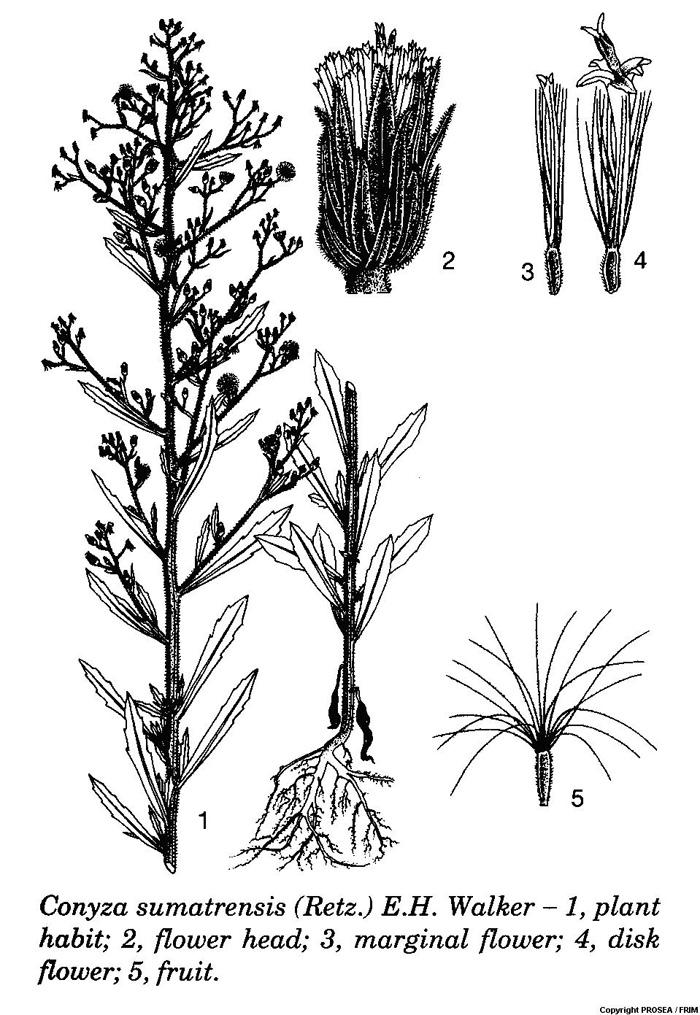Scientific Name
Erigeron floribundus (Kunth) Sch.Bip.
Synonyms
Baccharis ivifolia Blanco [Illegitimate], Conyza elata Kunth & Bouché, Conyza flahaultiana Sennen, Conyza floribunda Kunth, Conyza naudinii Bonnet, Conyza sumatrensis (Retz.) E.Walker, Dimorphanthes floribunda (Kunth) Cass., Erigeron flahaultianus Thell., Erigeron musashensis Makino, Erigeron naudinii (Bonnet) P.Fourn. [1]
Vernacular Name
| Malaysia | Chapa, sawi bulan, tembak-tembak hutan [2] |
| English | Fleabane [2] |
| Indonesia | Jalantir, monyenyen (Sundanese); sembung (Javanese) [2] |
| Vietnam | C[us]c voi [2] |
Geographical Distributions
Erigeron floribundus is originated from South America, but has at present a pantropical distribution. It has even spread as a weed to more temperate areas, e.g. in Europe. [2] This plant occurs gregariously in sunny or slightly shaded, dry or moist localities on a wide range of soils in regions with a weak or pronounced dry season. It can be found in grassland, roadsides, wasteland, fields, secondary forest, and rubber and tea plantations, from sea level up to over 3000 m altitude. [2]
Botanical Description
C. sumatrensis comes from the Compositae family. It is a short-lived perennial, erect herb that grows up to 350 cm tall. It is strongly branched in the upper part. [2]
The leaves are arranged alternate, simple, oblanceolate to linear-oblanceolate with a size of 3-12 cm x 0.3-3 cm and gradually tapering at base. The larger ones are sparsely coarsely dentate-serrate in the upper part while the smaller ones are often entire, sessile with grey hair on both sides. The stipules are absent. [2]
The inflorescence is a small cylindrical head, 5-6 mm long and together arranged in a long leafy panicle with many-flowered but short peduncle. [2]
The flowers are all tubular and they are about 4 mm long. The female flowers are marginal. Petal is with 2-lobed apex, pale yellow to purplish and shortly exserted from the involucre. The flowers disk is bisexual or male, with narrowly funnel-shaped petal widening into 5 lobes and pale yellow in colour. There are 5 exserted stamens that form a tube. The 1-celled ovary is inferior with style having2 short and thick arms. [2]
The fruit is small, compressed, ellipsoid achene, 1.5-2 mm long, with narrowed base and thickened margins with sparsely hairy. The pappus hairs are numerous, 1-2-seriate, 3-4 mm long, thin and toothed. [2]
The seedling is with epigeal germination. The hypocotyl is about 1 mm long. Cotyledons are subsessile and they are elliptical to ovate. The epicotyl is absent. [2]
Cultivation
No documentation.
Chemical Constituent
No documentation.
Plant Part Used
No documentation.
Traditional Use
No documentation.
Preclinical Data
No documentation.
Clinical Data
No documentation.
Poisonous Management
No documentation.
Line Drawing

References
- The Plant List. Ver1.1 Erigeron floribundus (Kunth) Sch.Bip. [homepage on the Internet]. c2013 [updated 2012 Feb 11; cited 2015 May 29] Available from: http://www.theplantlist.org/tpl1.1/record/gcc-120553
- Conyza sumatrensis (Retz.) E.H. Walker. In: Lemmens RHMJ, Bunyapraphatsara N, editors. Plant Resources of South-East Asia 12(3): Medicinal and Poisonous Plants 3. Leiden, Netherlands: Backhuys Publication; 2003.

